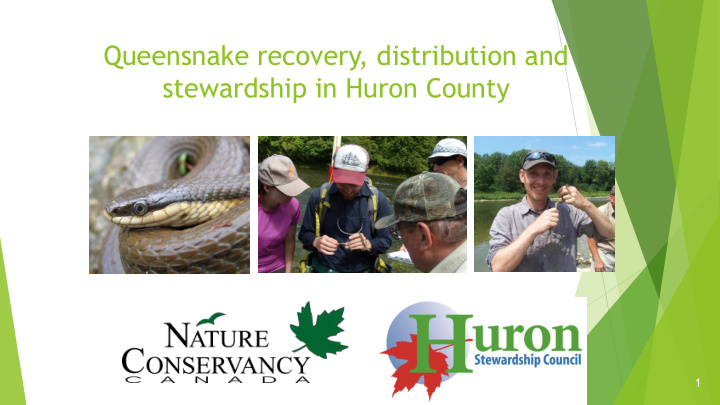



Queensnake recovery, distribution and stewardship in Huron County 1
2
Queensnake ( Regina septemvittata) Small to medium semi-aquatic snake Brown to olive back with narrow black stripes Belly is pale yellow with narrow black stripes 3
Queensnake ( Regina septemvittata) 4
Queensnake ( Regina septemvittata) Females are larger than males have an abrupt taper from vent to tail 5
Queensnake ( Regina septemvittata) Average Age Gender Weight (g) Length (cm) Female 59 44 Adult Male 54 39 Female 51 30 Sub-adult Male 48 27 Juvenile Unknown 36 16 Neonate Unknown 21 3 6
Queensnake ( Regina septemvittata) Hibernate through the fall and winter Emerge in spring Give birth to live young between July and September 7
Photos from OntarioNature.org Other snakes along the Lower Maitland Eastern Gartersnake Milksnake 8 Red-bellied snake Dekay’s Brownsnake
Where do Queensnakes live? 9
Where do Queensnakes live? Under or around medium- sized rocks along a river’s shoreline Areas with no woody vegetation, low water flow Crayfish present 10
11
12
13
Food source: Crayfish along the Maitland Two species of crayfish: Northern Clearwater Crayfish* (Orconectes propinquus) Virile Crayfish ( Orconectes virilis) Virile Crayfish Northern Clearwater Crayfish 14
Critical habitat features Areas that are critical for Queensnake survival and reproduction Parturition (birthing) sites Hibernation sites Movement between populations Potential hibernation site 15
Threats Habitat destruction and degradation Intentional human-caused death Unintentional human-caused death or disturbance (trampling) ATV, hiking, fishing Pollution Invasive plants and wildlife 16 Invasive Rusty Crayfish
Why should we care? Important part of the food web Diverse ecosystem is more resilient Indicator of watershed health 17
Research Questions How large are the populations in the Maitland? Does the availability of food (crayfish) influence the distribution and number of Queensnakes? What is the range of Queensnakes along the Maitland River? Photo: Joe Crowley Where do Queensnakes hibernate and give birth? How far do they move (up/down stream, in land, to hibernacula, etc.)? How can we work together to conserve this sensitive species? 18
Mark-Recapture Repeated surveys at same sites During each survey, observed snakes are marked Commonly used technique: proportion of un-marked to marked individuals is used to calculate total population size estimate Started in 2012 and ongoing in 2013 19
Mark-Recapture 5 survey sites on the Maitland River Sites are surveyed every 4 weeks Habitat and crayfish are also studied 20
Mark-Recapture: Results 2012: 71 snakes marked 2013: 62 snakes marked so far Analysis of data ongoing 21
Exploratory Surveys, 2011-13 2011 – 88 snakes at 16 different locations along the Lower Maitland River Caught 27 snakes in one day, identified possible parturition site Searched the Nine Mile River and Bayfield River (ABCA) 22
Nine Mile River 23
Results 2011 Average # hours spent Average # of rocks flipped River(s) locating one snake to locate one snake Maitland, Nine Mile, and 4 2970 Bayfield Maitland 3.6 2829 Maitland River excluding 5 4169 outlier 24
Exploratory Surveys, 2011-13 2011 – 88 snakes at 16 different sites along the Lower Maitland River Caught 27 snakes in one day, identified possible parturition site Searched the Nine Mile River and Bayfield River (ABCA) 2012 - 119 snakes, found snakes in 3 new locations Identified potential hibernacula 25
26
Exploratory Surveys, 2011-13 2011 – 88 snakes at 16 different sites along the Lower Maitland River Caught 27 snakes in one day, identified possible parturition site Searched the Nine Mile River and Bayfield River (ABCA) 2012 - 119 snakes, found snakes in 3 new locations Identified potential hibernacula 2013 – searching for 80.75 person hours, found snakes in 3 new locations 27
28
Implications of the Results Learn more about the species’ range Identified large populations that could be used to study the species more in depth (mark-recapture survey, habitat use, population size, demographics) Contributing to the National Heritage Information Centre, Ontario Nature’s Reptile and Amphibian Atlas Improving the recovery strategy Raise public awareness 29
Implications of the Results “The fact that you and your crew have successfully located numerous snakes along multiple river sites over a relatively short period of time is in itself remarkable based on past efforts to survey for this species .” (Scott Gillingwater) “Information gathered from this study will provide currently unavailable data for the species, not only in the Maitland watershed, but for the species across its Canadian range.” (Scott Gillingwater) The Maitland River remains healthy – therefore it’s probably the best opportunity we have to collaborate with local conservation partners and the community to conserve a Queensnake population in Ontario 30
Future Goals for Recovery Continue mark-recapture surveys Delineate habitat features Crayfish surveys and research Use of telemetry Continue education 31
What can I do? Ontario Nature’s Reptile and Amphibian Atlas Spread the word! Keep our river healthy Maintain natural vegetation along the shoreline 32
Benefits of having Species at Risk on your property Preserving sensitive species and habitats adds to the overall resiliency of the system Funding is available for projects on your property Species at Risk Farm Incentive Program (up to 80% funding) Habitat protection in livestock systems (removing watering systems, fencing, improved stream crossings) Habitat development (planting trees, native grass habitat restoration, wetland restoration, etc.) Restoration of degraded areas (invasive plant species control) Planning for action (grazing management, soil erosion control, biodiversity enhancement, riparian health assessment) Lois Sinclair lsinclair@ontariosoilcrop.org cell: 519 955 3139 33
How can I learn more? Websites: Ontario Nature, Ministry of Natural Resources, the Nature Conservancy of Canada Take home a Stewardship Guide, fact sheet Visit the NCC website – updates on Huron County research Survey sheets 34
Recommend
More recommend